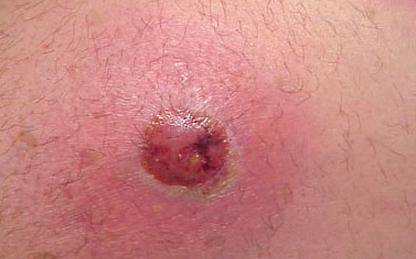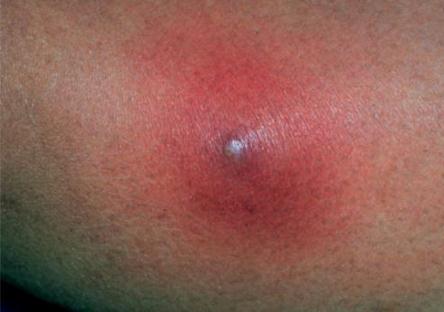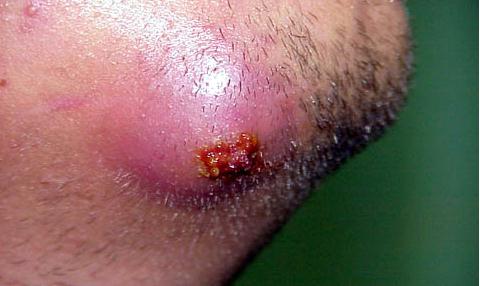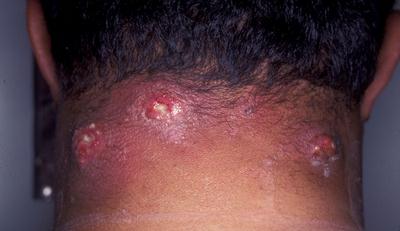Furuncle – Definition, Treatment, Pictures, Causes, Symptoms
What is Furuncle?
Furuncle is a skin infection surrounding the follicles of the hair, also termed as boils. It is a bacterial infection that results in swelling of the skin around the hair follicle with resulting pus and tissue debris formation. This condition is known as an abscess formation where pus accumulates beneath the dermis and extends to the subcutaneous area. When multiple hair follicles inflame and fuse, they are known as carbuncles. Reccurring boils is termed as furunculosis
Furuncle Causes
Main Cause
The main source of furuncle is a bacterium called Staphylococcus aureus. It is a gram positive, round microorganism which is present in most of the areas of the body, specifically the skin. It is a transient micro flora in the skin which does not cause significant illness when there is no open wound. In furuncles, when the hair follicles are exposed such as in removal of a hair shaft, microorganisms tend to enter and proliferate, causing infection. Since they are an opportunistic bacteria, they also multiply and grow when the immune system weakens.
Other causes and risk factors
The Tumbu fly in Africa causes myiasis which results in furuncles. Aside from this, underlying conditions such as diabetes mellitus, malnutrition, anemia, neoplasms, intake of immunosupressants, and antibiotic overuse increases the risk for developing furuncles because of growth of opportunistic microorganisms such as S. aureus.
Furuncle Signs and Symptoms
Manifestations of boils include both local as well as systemic signs and symptoms.
Local Manifestations
Local signs and symptoms of furuncle include:
- Pustules (contains pus), pea-sized lesion located on the hair follicle. Advanced infection may be as large as a ping-pong ball
- Redness, swelling, and warm skin around the infected site
- Whitish to yellowish pinpoint on top of the boil can be observed when it is ready to drain pus.
- Mild to moderate pain on the lesion
Systemic Manifestations
When furuncles are severe, they tend to produce systemic sign and symptoms as a sign of spread of the infection. These include:
- Fever
- Lymph node swelling, especially the ones adjacent or near the furuncle
- Body malaise and fatigue
- Itching
When furuncles drain, the lesion opens and a whitish to yellowish pus oozes out. Once the infection is resolved, the lesion dries and turns into scab and leaves a dark spot when completely healed within two weeks.
Furuncle Diagnosis
Diagnosis is done through culture and sensitivity tests. A culture is often done by getting a sample of the drain to allow the bacteria to grow and replicate. Once it has been achieved, sensitivity tests to several antibiotics are done to determine the most appropriate medication to be given where the bacteria is most sensitive.
Furuncle Treatment
Although furuncles may heal on their own as long as further infection is prevented, some cases need to be managed by health practitioners. It is best to consult physicians to select appropriate treatments and recommendations. Treatments of furuncles include medical and surgical as well as a supportive approach.
Medical Management
Oral Antibiotic therapy
Antibiotics are the primary treatment for furuncles since it is an infectious disease. The most common antibiotics used is penicillin. These are the first line of drugs for furuncles, however, patients should take the medication as prescribed (seven to ten days depending on the severity of the infection) to prevent drug resistance. Methicillin Resistant Staphylococcus aureus (MRSA) is a severe, life-threatening infection as a result of non-compliance to antibiotic therapy. Antibiotics also need to be administered by mouth or intravenously. Local application such as sprinkling of antibiotic powders is not effective because absorption is not optimum.
Topical application of antibiotics.
Some antibiotics are prepared as creams and ointments. These are an approved and prescribed way of applying local antibiotics rather than sprinkling powder from antibiotic capsules. The boil needs to be washed thoroughly with soap and water before topical application of creams.
Surgical Management
Perform Incision and Drainage
Surgeons usually perform incision and drainage to open the lesion and lremove pus and other debris. This should be done by medical professionals only because doing this at home can cause more infection. Sterile equipment is used in the hospital or clinics to prevent further infection. After the surgical procedure, antiseptics such as iodine or antibiotic creams are applied to kill transient microorganisms. A bandage may be placed to prevent further entry of bacteria and other microorganisms in the wound and promote healing. Bandages should be replaced every day aseptically. Physicians and nurses usually provide home instructions on how to replace the bandage.
Supportive management
Furuncles should be continuously managed at home. In some cases where patients are unable to consult health practitioners, home management can be instituted to reduce symptoms. However, consultation should be done whenever possible. Home management includes:
Apply warm packs over the affected area
A warm compress applied over the furuncle helps to drain the pus and hastens healing. Do this by using a soft cloth soaked in warm water. Do not open the wound by other means and never squeeze out the pus. Physicians should be the one to do that to prevent reentry of bacteria. Warm packs also sooth the skin and reduce pain.
Clean the infected area
Always clean the boils with soap and water and other antiseptic washes to reduce bacteria. Also, apply antiseptic creams as prescribed. Never place erosive and irritating chemicals such as alcohol to prevent further injury.
Apply dressings.
Use dressings to cover the boil and change them every day. Properly dispose of the infected article to prevent spread of infection.
Hand washing
Wash your hands before and after contact with the lesion to prevent spread of bacteria.
Never re-use towels and never borrow and lend them to others.
Re-using towels will just bring the bacteria in contact with the skin again and spread it to other areas of the body. Borrowing and lending personal articles such as clothes and towels can lead to cross infection.
Boils usually heal on their own when they are not complicated. Healthcare practitioners should be consulted when the boil is too deep or too large, boils last more than two weeks, systemic manifestations are present, for recurring boils, and any boil present on the face and back.
Furuncle Complications
Staphylococcus aureus may spread to other areas of the body, causing more serious complications such as:
Spinal cord, kidney, and brain abscess
Infection may reach vital organs and cause infection in the area.
Osteomyelitis
Bones are one of the potential areas of spread due to blood circulation. When osteomyelitis occurs, the patient may have severe bone diseases and fractures.
Pneumonia
The lungs are easily infected because Staphylococcus aureus are always present in the nostrils. Any furuncle in the area may descend to the lungs.
Endocarditis
When the heart muscle (endocardium) becomes infected, myocardial contractility may be impaired and lead to circulatory problems.
Sepsis
Bacteria may spread and multiply in the blood stream, causing sepsis.
Increased severity of other diseases
Presence of S. aureus may intensify effects of toxic shock syndrome, food poisoning, septic shock, and burns.
Furuncle Prevention
Since furuncles are primarily due to infection, it is an easily-preventable disease. The following prevention strategies are essential in avoiding furuncles and other infections.
Proper hygiene
Thorough hand washing and bathing every day helps in reducing S. aureus. It also prevents clogging of hair follicles and the spread of infection.
Antimicrobial soaps
Use soaps with antimicrobial properties to kill potentially harmful bacteria.
Antiseptic washes and disinfectants
Use alcohol and hand sanitizers when washing is not possible such as in areas with no accessible water and soap. If wound is present, clean it with antiseptics such as povidone-iodine to prevent infection.
Furuncle Pictures


Image 3 – Furuncle At nape of neck

Image 4- Furuncle at chin
